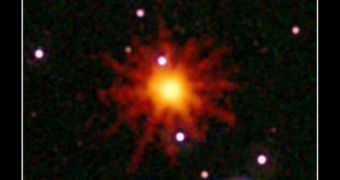Last week, astronomers observed a massive, extremely energetic explosion in space. They now say that it may have been produced just as a massive star was destroyed by a black hole, which will now grow even more because it will have more “feeding” material at its disposal.
Experts are still surprised by the magnitude of the explosion they witnessed. At this point, it's still unclear what happened, but some say that the light the event contained had a signature similar to that of gamma-ray bursts (GRB).
The light was produced in a region of space located far away from Earth, in the direction of the constellation Draco. The exact distance between us and the dying star was calculated by be around 3.8 billion light-years.
Telescopes and automated observation networks began picking up the explosion on March 28. Since then, it has become gradually brighter, and is now beginning to fade away. Given the distance to the dying star, the actual explosion occurred billions of years ago, but its light is visible only now.
Officials with the American space agency say that this is the brightest and most variable explosion they ever recorded in space. It's also the longest ever observed, they add, especially if it turns out to be a GRB after all, Space reports.
“We know of objects in our own galaxy that can produce repeated bursts, but they are thousands to millions of times less powerful than the bursts we are seeing now. This is truly extraordinary,” explains expert Andrew Fruchter.
The scientist holds an appointment at the Space Telescope Science Institute (STScI), in Baltimore, Maryland. He made the announcement in a statement released on Thursday, April 7. A large number of observatories, both from NASA and other groups, are now tracking the event.
The signal was originally identified by the NASA Swift X-ray satellite, in the form of a light pulse. It turned out to be the first in many, and an alert was immediately issued to the international astronomical community, calling for continuous monitoring.
Since March 28, the event has been known as GRB 110328A. The Chandra X-ray Observatory and the Hubble Space Telescope were both pointed at the source of the explosion on Monday, April 4, to pinpoint its exact location.
“The fact that the explosion occurred in the center of a galaxy tells us it is most likely associated with a massive black hole. This solves a key question about the mysterious event,” says Neil Gehrels.
The expert, who is the lead scientist for the Swift mission, made the announcement in a new statement. He holds an appointment at the NASA Goddard Space Flight Center (GSFC), in Greenbelt, Maryland.
“The best explanation at the moment is that we happen to be looking down the barrel of [a black hole] jet. When we look straight down these jets, a brightness boost lets us view details we might otherwise miss,” adds University of Warwick astronomer Andrew Levan.

 14 DAY TRIAL //
14 DAY TRIAL //